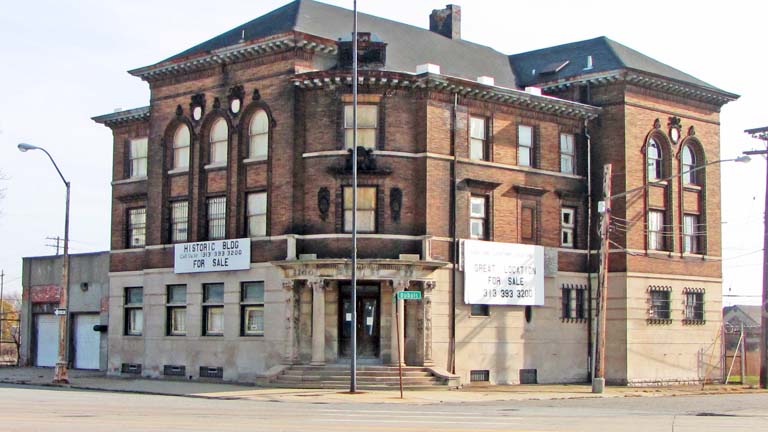

This building is listed on both the National Register of Historic Places and the State of Michigan register. It deserves those listings since it reflects the strong interest the city’s leaders had in erecting an impressive structure that would convey the importance of Detroit and its police department. The population of the city soared from 206,000 in 1890 to 286,000 in 1900 as Detroit became a national manufacturing center. Much of the population growth took place in the near east side. German immigrants had been living in this area since the 1870s, but after 1880, many Polish and other eastern European immigrants arrived as evidenced by the numerous churches dating from the 1880s and 1890s in this neighborhood. As a prosperous city, Detroit commissioned Edward Van Leyen to design an impressive police building in the then popular Beaux Arts style. His design survives very well almost 120 years after he sketched it. Shortly after designing this building, he designed the Casino that still stands on Belle Isle. One other Van Leyen design on this Detroit1701 site is St. Theresa of Avila on Quincy on Detroit’s West Side.
The lower floor is faced in gray limestone. The upper two stories are faced in yellow ochre brick. The entrance way is an attractively curved corner bay. It displays pilasters and limestone columns. Note that you must ascend a few stairs to go into this police station—a reminder to everyone that this was an important building, not a tavern or store that would have its entry at street level. And lest you forget, this is a police facility, there are carvings of the police shield and police officers above the columns. Van Leyen designed tall pavilions to face both Hunt Street and DuBois. The second and third floor windows of these pavilions are linked by having arched hoods. There is also an elaborate metal cornice designed by the Detroit Cornice and Slate firm, a still-active firm whose original building at 733 St. Antoine is also listed on both the state and national historic register.
When this building opened, it was, apparently, staffed by 36 officers. Unions, at that time, had not yet succeeded in popularizing the idea that the work day should last for only eight hours. That developed in the 1920s after bitter strikes in the steel industry. So when this building opened, officers worked 12-hour shifts. The first training school for police cadets in the nation was housed on the upper floors of this structure. At the start this was the home of the Second Precinct, but in 1910, the precincts were reorganized and this became headquarters for the Third Precinct.
In 1959 the Third Precinct was merged with the Seventh precinct. I believe that the building was sold and used for offices for some time. Later it became a vacant building and, about 2010, was put on the market for just under one million dollars. As of writing this, it was still for sale. The nearby Eastern Market neighborhood and business entrepôt appears to be thriving with the regular opening of apartments and lofts in renovated late Nineteenth Century buildings. You wonder if an entrepreneur will purchase the elegant Hunt Street Police Station or the nearby Engine House #11 for conversion to residential purposes.
Date of completion: 1896
Architect: Edward C. Van Leyen
Architectural style: Beaux Arts
Use in 2014: Empty building currently for sale
City of Detroit Designated Historic District: Not listed
State of Michigan Registry of Historic Sites: Listed P25,264
State of Michigan Historical Marker: None
National Register of Historic Places: Listed February 29, 1980
Photograph: Ren Farley; November 17, 2012
Description updated: January, 2014